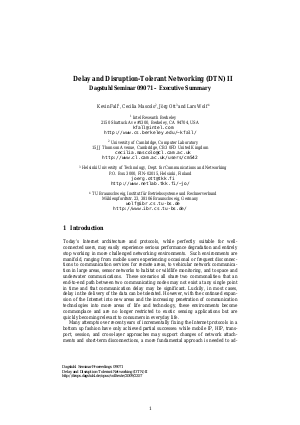09071 Executive Summary – Delay and Disruption-Tolerant Networking (DTN) II
Authors Kevin Fall, Cecilia Mascolo, Jörg Ott, Lars Wolf
-
Part of:
Volume:
Dagstuhl Seminar Proceedings, Volume 9071
Part of: Series: Dagstuhl Seminar Proceedings (DagSemProc) - License:
 Creative Commons Attribution 4.0 International license
Creative Commons Attribution 4.0 International license
- Publication Date: 2009-12-16
File

PDF
DagSemProc.09071.2.pdf
- Filesize: 38 kB
- 5 pages
Document Identifiers
Subject Classification
Keywords
- DTN
- simulations
- mobility
- MANET
- delay-tolerant networking
- ad-hoc networking
- routing
Metrics
- Access Statistics
-
Total Accesses (updated on a weekly basis)
0PDF Downloads0Metadata Views
Abstract
Today's Internet architecture and protocols, while perfectly suitable for well- connected users, may easily experience serious performance degradation and entirely stop working in more challenged networking environments. These correspondong scenarios all share two commonalities: that an end-to-end path between two communicating nodes may not exist at any single point in time and that communication delay may be significant. With the continued expansion of the Internet into new areas, these environments become commonplace and are no longer restricted to exotic sensing applications but are quickly becoming relevant to consumers in everyday life. Many attempts over recent years of incrementally fixing the Internet protocols in a bottom up fashion have only achieved partial successes, and a more fundamental approach is needed to address networking environments in which delays and disconnections may last for significant periods of time, and are the rule rather than the exception. Delay-tolerant Networking (DTN) has taken a more encompassing approach to dealing with virtually all types of connectivity challenges, from bit rate to errors to delays to disruptions. By providing a novel communication abstraction that relies exclusively on asynchronous hop-by-hop message passing with no need for instant end-to-end connectivity, DTN concepts enable communications even under adverse conditions. This comes, however, at the cost of interactivity of communications, rendering any kind state synchronization or validation more difficult and raising new challenges. These include routing protocols – that need to operate under often unknown future conditions, security mechanisms – that can no longer carry out instant key derivation or validation even if a security infrastructure was in place, and applica- tion protocols and paradigms – that can no longer rely on simple lower layer abstrac- tions promising (mostly) instant and reliable interactions.
Cite As Get BibTex
Kevin Fall, Cecilia Mascolo, Jörg Ott, and Lars Wolf. 09071 Executive Summary – Delay and Disruption-Tolerant Networking (DTN) II. In Delay and Disruption-Tolerant Networking (DTN) II. Dagstuhl Seminar Proceedings, Volume 9071, pp. 1-5, Schloss Dagstuhl – Leibniz-Zentrum für Informatik (2009)
https://doi.org/10.4230/DagSemProc.09071.2
BibTex
@InProceedings{fall_et_al:DagSemProc.09071.2,
author = {Fall, Kevin and Mascolo, Cecilia and Ott, J\"{o}rg and Wolf, Lars},
title = {{09071 Executive Summary – Delay and Disruption-Tolerant Networking (DTN) II}},
booktitle = {Delay and Disruption-Tolerant Networking (DTN) II},
pages = {1--5},
series = {Dagstuhl Seminar Proceedings (DagSemProc)},
ISSN = {1862-4405},
year = {2009},
volume = {9071},
editor = {Kevin Fall and Cecilia Mascolo and J\"{o}rg Ott and Lars Wolf},
publisher = {Schloss Dagstuhl -- Leibniz-Zentrum f{\"u}r Informatik},
address = {Dagstuhl, Germany},
URL = {https://drops.dagstuhl.de/entities/document/10.4230/DagSemProc.09071.2},
URN = {urn:nbn:de:0030-drops-23574},
doi = {10.4230/DagSemProc.09071.2},
annote = {Keywords: DTN, simulations, mobility, MANET, delay-tolerant networking, ad-hoc networking, routing}
}
